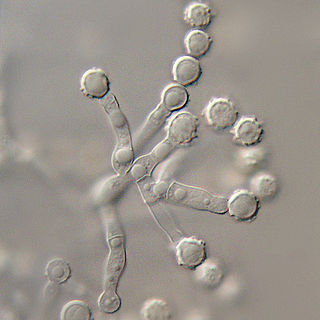
Fusarium/fjuˈzɛəriəm/ (help·info) is a large genus of filamentous fungi, part of a group often referred to as hyphomycetes, widely distributed in soil and associated with plants. Most species are harmless saprobes, and are relatively abundant members of the soil microbial community. Some species produce mycotoxins in cereal crops that can affect human and animal health if they enter the food chain. The main toxins produced by these Fusarium species are fumonisins and trichothecenes. Despite most species apparently being harmless, some Fusarium species and subspecific groups are among the most important fungal pathogens of plants and animals.

The Hypocreales are an order of fungi within the class Sordariomycetes. In 2008, it was estimated that it contained some 237 genera, and 2647 species in seven families. Since then, a considerable number of further taxa have been identified, including an additional family, the Stachybotryaceae. Wijayawardene et al. in 2020 added more families and genera to the order. According to the Catalog of Life, As of April 2021 the Hypocreales contains 6 families, 137 genera, and 1411 species. Hyde et al. (2020a) listed 14 families under Hypocreales, while, Wijayawardene et al. (2022) accepted 15 families in the order, where Cylindriaceae was additionally added. Earlier, Hyde et al. (2020a) had placed Cylindriaceae in class Xylariomycetidae. Samarakoon et al. (2022) agreed. Hence, Cylindriaceae should have been excluded from Hypocreales and placed in Xylariomycetidae. Xiao et al. (2022) recently introduced a new family Polycephalomycetaceae to Hypocreales.

The Nectriaceae comprise a family of fungi in the order Hypocreales. It was circumscribed by brothers Charles and Louis René Tulasne in 1865. In 2020, an Outline of fungi was produced and listed 70 genera and about 1,336 species.

Stachybotrys is a genus of molds, hyphomycetes or asexually reproducing, filamentous fungi, now placed in the family Stachybotryaceae. The genus was erected by August Carl Joseph Corda in 1837. Historically, it was considered closely related to the genus Memnoniella, because the spores are produced in slimy heads rather than in dry chains. Recently, the synonymy of the two genera is generally accepted. Most Stachybotrys species inhabit materials rich in cellulose. The genus has a widespread distribution and contained about 50 species in 2008. There are 88 records of Stachybotrys on Species Fungorum, of which 33 species have DNA sequence data in GenBank. Species in the genus are commonly found in soil, plant litter and air and a few species have been found from damp paper, cotton, linen, cellulose-based building materials water-damaged indoor buildings, and air ducts from both aquatic and terrestrial habitats.
Fusarium incarnatum is a fungal pathogen in the genus Fusarium, family Nectriaceae. It is usually associated with over 40 phylogenetic species in the natural environment to form the Fusarium incarnatum-equiseti species complex(FIESC). This complex is widespread across the globe in subtropical and temperate regions, resulting in many reported cases of crop diseases. It produces various mycotoxins including trichothecenes zearalenone, causing both plant and animal diseases.

Fusarium solani is a species complex of at least 26 closely related filamentous fungi in the division Ascomycota, family Nectriaceae. It is the anamorph of Nectria haematococca. It is a common soil fungus and colonist of plant materials. Fusarium solani is implicated in plant disease as well as human disease notably infection of the cornea of the eye.

Bipolaris is a genus of fungi belonging to the family Pleosporaceae. It was circumscribed by mycologist Robert A. Shoemaker in 1959.

Microascus is a genus of fungi in the family Microascaceae.

Pestalotiopsis is a genus of ascomycete fungi in the Sporocadaceae family.

Seiridium is a genus of plant pathogens in the family Sporocadaceae.
Lasiodiplodia is a genus of fungi in the family Botryosphaeriaceae. There were about 21 species. Lasiodiplodia, commonly referred to as black-soot disease, is a significant pathogen in tropical forestry.
Neocosmospora is a genus of fungi in the family Nectriaceae.

Stemphylium is a genus of fungal plant pathogen.

The Didymellaceae are a family of fungi in the order Pleosporales. The have a world-wide distribution.
Clonostachys is a genus of fungi in the order Hypocreales and family Bionectriaceae.

The Stachybotryaceae are a family of fungi in the order Hypocreales; the genera it contains have been described as "hyper-diverse".
Volutella is a genus of fungi belonging to the family Nectriaceae.
Mariannaea is a genus of fungi belonging to the family Nectriaceae.
Microcera is a genus of Ascomycete fungi in the Nectriaceae family.











